Localization Project Management Best Practices
This page contains the talk of Frank Bergmann at the 27th Unicode
Conference in Berlin on April 8th, 2005.
There is a Wiki available
with supplementary information about the best practices presented
in this paper.
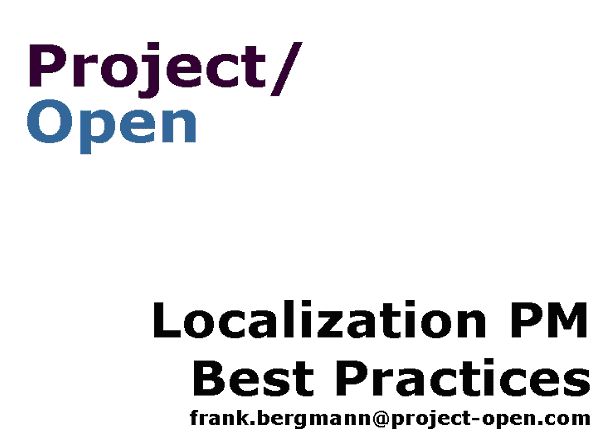
In this presentation I am going to address the subject of “best
practices” in the management of localization projects (the
process of translating and modifying a software product in order
to adapt it to a specific cultural environment).
The term “best practices” is frequently used when
a subject area is not very well understood scientifically and refers
to a number of “lessons learned” and “war stories”
from previous experiences.
The best practices that I’m going to present in this talk
are derived from my personal experience as a software developer
and localization consultant. These experiences have led me to initiate
“]project-open[” in order to “tackle” some
of the issues that we have encountered in this field. So please
consider that my views may be biased. The vast amount of feedback
we have received from customers, however, mostly confirms our interpretation.
In this talk we are going to take a “unified” view
of l10n PM, covering all parts of the project value chain without
distinguishing between PM at the customer level (the software company)
and PM at the provider level (the translation agencies). The exact
distribution of work between the customer and the providers depends
on each customer’s sourcing strategy and is beyond the scope
of this talk.
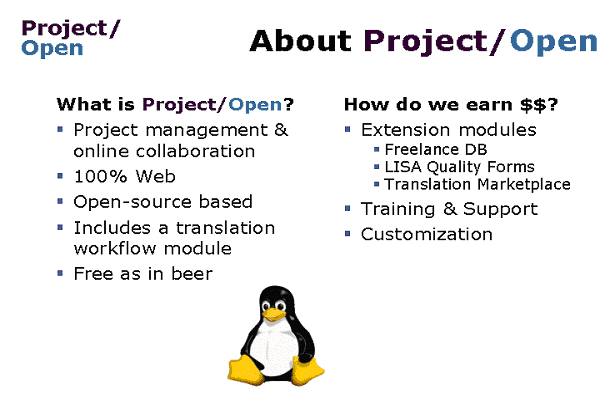
]project-open[ is an open-source based project management application.
]project-translation[ is a specific version of ]po[
that includes several translation specific extension modules such
as:
- Translation memory (Trados) integration
- Translation workflow
- Semiautomatic invoice and purchase order generation
]po[
is free and mostly licensed under the GPL open-source license. In
order to generate revenue, however, we are offering closed-source
extension modules for ]po[
and professional services such as installation, training, support
and customization.
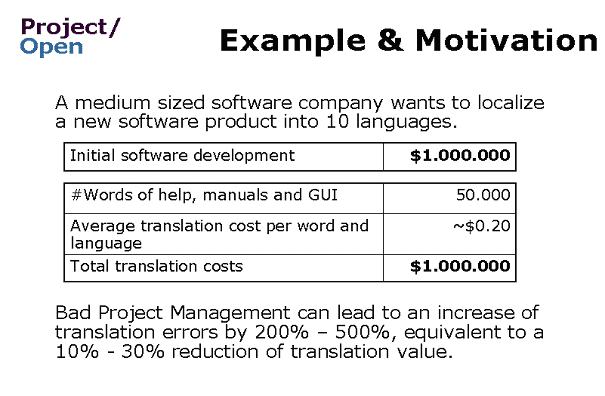
Before entering into the details of Localization Project Management,
we want to demonstrate the relevance of the subject using the example
of a medium sized company that has invested about 10 man-years into
the development of a software product. This company may experience
that localizing this product into 10 languages will cost about the
same amount as the cost of the project’s initial development.
Difficulties during the localization of the product due to poor
l10n PM can lead to a reduction in translation quality.
However, an equivalent quality might have been accomplished using
a cheaper translation process, for example by skipping the terminology
or final review phases of the project. Translation agencies, on
the other hand, need to charge higher prices than inexperienced
software companies due to the increased overhead and the risk of
potential rework common in the translation field.
(The slide above contains an error. It should read 500.000 words
of documentation.)
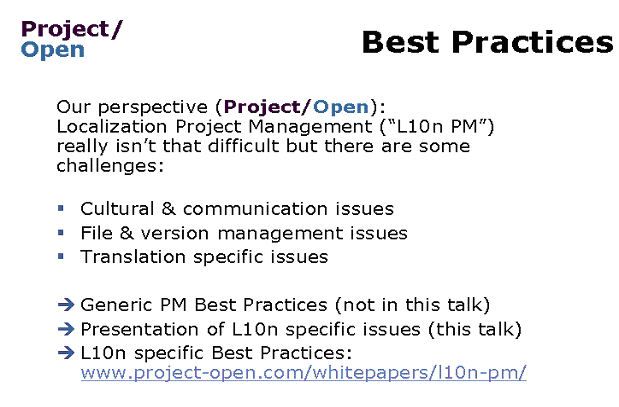
In order to understand best practices in l10n PM we first want
present the challenges that can be found in this type of project.
The complexities of l10n PM are very different from the complexities
of software development projects. Unlike software development projects,
l10n projects are usually well defined and scoped, there are few
interdependencies of tasks (as we will see later on) and there exist
well-established and precise procedures to estimate time and costs.
Instead, the complexities of l10n projects arise due to the number
of participating parties, their cultural diversity and the provision
of large numbers of files to the participating parties. Also, important
project stakeholders frequently lack the awareness of these complexities.
A number of best practices have emerged to tackle these challenges.
However, we won’t be able to enumerate and explain all of
these best practices in this talk. Also, many of these best practices
can be found in the literature about generic project management.
This is why we want to focus in this talk on the complexities
underlying these best practices in l10n PM and have included a list
of best practices in this handout as a reference. For a detailed
best practices list, complete with examples, please refer to the
URL http://projop.dnsalias.com/l10n-pm/.
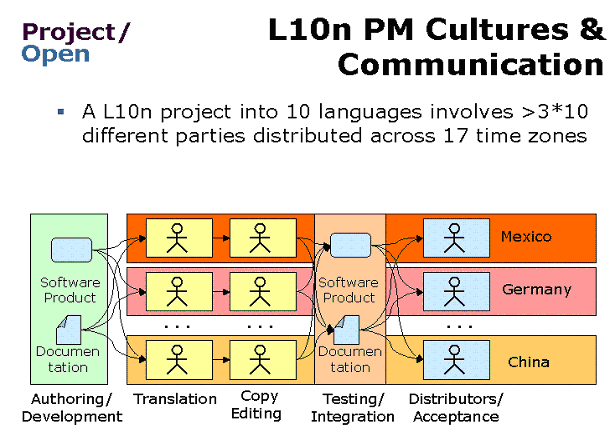
The most obvious element of complexity in l10n projects is the
number of parties (companies, or persons) involved in it and their
geographic distribution (see the typical example in the slide above).
The geographic distribution of the parties is due to the fact that
translators and the distribution organization are located close
to the target markets.
For each language, we will find:
- One or more translators
- One or more copy editors or proof readers
- One or more distributors in the local market that are the “final
customers“ of the localized product
Managing a large number of parties across several time zones already
presents a lot of challenges. Cultural differences are an added
difficulty. The differences include:
- Transaction-oriented cultures vs. relationship-oriented cultures
- Different priorities in the balance between work and leisure
- Different perceptions in the importance of commitments
And these differences become even more important when there are
difficulties in (English) language comprehension and the absence
of face-to-face conversations.
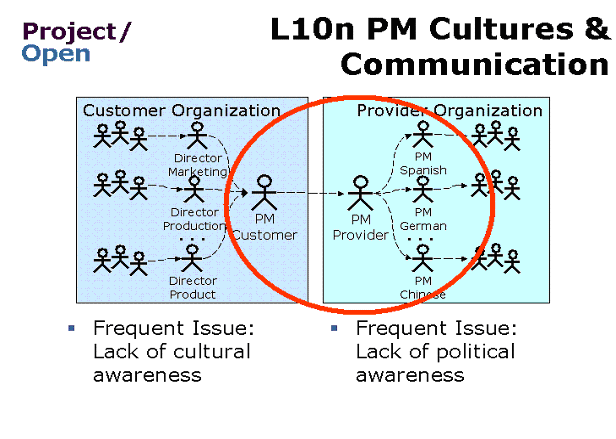
Two other types of communication issues are related to the typical
division of an l10n projects into a “customer organization”
and a “provider organization” as depicted above (one
main contractor working with one subcontractor for each language).
These two organizations normally do not communicate with each other
because the main contractor fears that the subcontractors will start
working directly with the customer in the next project.
- The lack of contact between the customer (marketing, software
development, etc.) and the providers (language experts) leads
to a poor understanding of each others’ needs. The customer’s
staff typically doesn’t understand the importance of cultural
and language issues, while the providers frequently fail to see
their work within the greater business context.
- The lack of contact also proves to be very inefficient during
the execution of the project because all communication passes
through the bottleneck of the two main PMs.
However, unlimited communication can also result in chaotic situation
with unclear decision structures, so best practices in this area
include Internet discussion forums and web-based incident management
software that carefully structure communication.
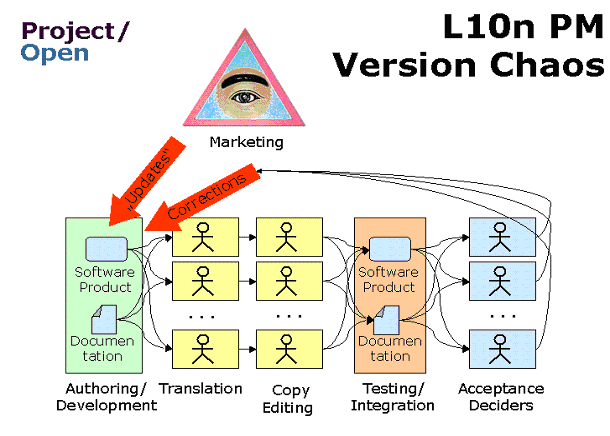
A second main source of complexity in l10n project is due to the
high number of documents that need to be distributed across the
project participants. The files are frequently sent as ZIP files
via email, providing abundant space for human errors, both for the
translators and the project managers.
“Acceptance deciders” – the sales & distribution
organization in the target markets –have to conduct the final
check of the documents, leading to partial repetitions of the document
loop with the appropriate corrections.
This situation is even further complicated when changes are made
to the original English texts during the course of the project.
These “late” modifications need to be introduced manually
into the translation chain and lead to the existence of multiple
versions of the same set of files, which in turn leads to frequent
errors and substantial management overhead.
Best practices in this area include techniques to avoid late changes
and translation workflow solutions that automatically handle the
distribution of documents.
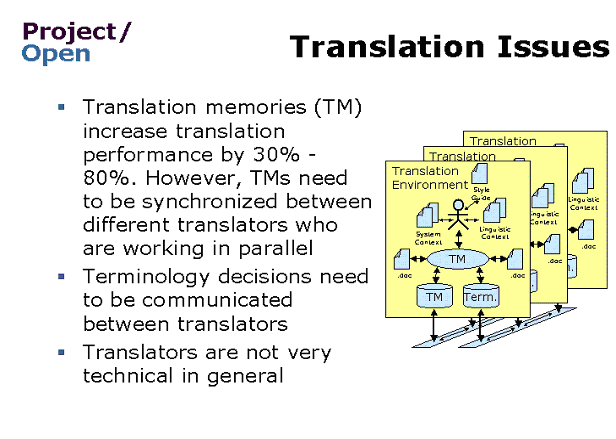
A third main complexity issue in l10n projects is the synchronization
of translation memories (“TM’s”, http://en.wikipedia.org/wiki/Translation_memory)
and glossaries between translators who work on texts of the same
language.
TM and terminology synchronization issues become more relevant
as a function of the required translation quality and of the project
size, the number of translators who are concurrently working on
every language. Synchronization requires a “language leader”
someone who is in charge of collecting and integrating TMs. It requires
N:1 (collection) and 1:N (update) communication patterns. Best practices
in this area include the provision of glossaries and “context”
early in the project and web-based applications for managing the
TM synchronization process.
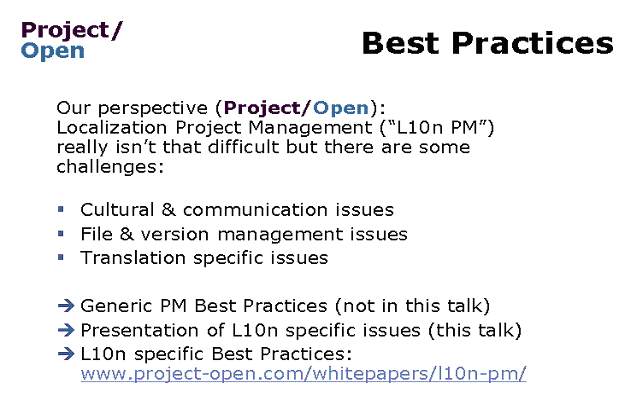
Please find below the current version of the l10n PM best practices
list (we are not going to explain these best practices during the
talk). For details and to see an updated version, please visit the
link: http://projop.dnsalias.com/l10n-pm/.
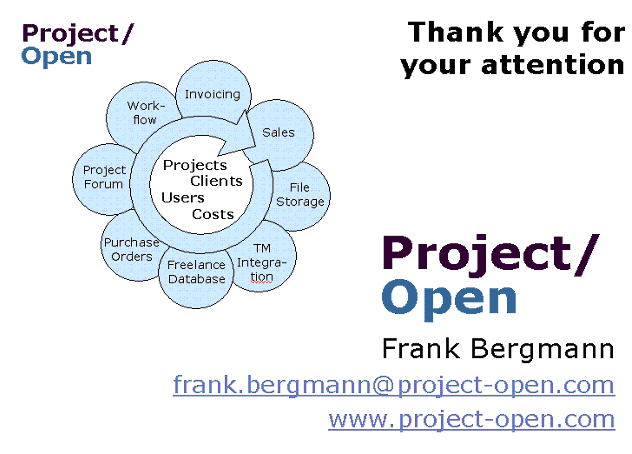
|

